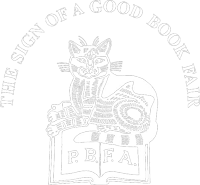
Yeats, W.B. & Yeats, J.B. [Illus.] ~ The Secret Rose
First UK Printing : Lawrence & Bullen, Limited, London: 1897
8vo., blue cloth fully and elaborately blocked in gilt with titles, borders, and tree design to upper board and spine; circular motif to lower; all designed by Althea Gyles; outer edges untrimmed; title in red and black, with printer’s device; black and white frontis behind mounted tissue and a further six full page illustrations by the author’s brother; The BOOK with one mild central crack to hinge, but holding firm; some browning, spotting and offsetting to the end-leaves and frontis tissue; A neat ownership name to front free endpaper; gilt to spine a little dulled, with some mild pushing, fraying and minor nicks to the spine ends ; Very slight rubbing to the lower edges of boards, with a little loss of colour; Remains a Very Good++, bright copy, in superior condition to those often found. The book is protected in a removable Mylar archival cover. First printing, first issue with "Lawrence & Bullen" imprint at the base of spine. The binding is described by Richard Ellmann in The Identity of Yeats (1968) thus: it “was intended to make the book resemble a grimoire. At its centre is a four-petalled rose joined to a cross, occupying a place just below the middle of the tree. The boughs of the tree resemble a serpent’s folds; among them, just above the rose, are the kissing faces of a man and woman, in the midst of the serpentine folds of the Tree of Life. The three roses at the top represent the three principal states of being (Sephiroth) of the Kabbalistic Tree, and the skeleton at the bottom represents the lowest state of being or nature”. In many ways a collaboration between three important artists; the Irish writer and Nobel Prize-Winner William Butler Yeats, one foremost figures of 20th-century literature; his brother Jack, artist and Olympic medalist; and Althea Gyles, poet, artist, and book cover designer. Both Gyles and Yeats had become interested in the Hermetic Order of the Golden Dawn, with Yeats becoming particularly involved with Theosophy and Gyles living for a time in a theosophical commune with such others as George William Russell (to whom ‘The Secret Rose’ is dedicated). Yeats joined the household in 1891, describing Gyles as "a strange red-haired girl, all whose thoughts were set upon painting and poetry." The cabbalistic iconography of the order strongly influenced her design for The Secret Rose (1897), and she went on to provide the cover design for his Poems (1899) and The Wind among the Reeds (1899). Yeats later went on to describe her thus: “Miss Althea Gyles may come to be one of the most important of the little group of Irish poets who seek to express indirectly through myths and symbols, or directly in little lyrics full of prayers and lamentations, the desire of the soul for spiritual beauty and happiness…precise symbolism never interferes with the beauty of design, are as yet her most satisfactory expression of herself.” The Secret Rose was a monumental work on the growing Celtic Movement in Literature at the turn of the century. Drawing upon Celtic mythology, the title is derived from a love poem “To the Secret Rose”, included here as a Preface: “Far off, most secret, and inviolate Rose,/Enfold me in my hour of hours…” Yeats was widely credited as being one of the main driving forces behind the Irish Literary Revival, or ‘Celtic Twilight’, which saw a flowering of Irish literary talent in the late 19th and through to the early 20th century. As well as mythology, Yeats draws on repeated Christian and Biblical symbolisms throughout the text, predominantly the crucifixion, as evidenced by Jack Yeats’ illustration facing p. 36, which shows ‘The Crucifixion of the Outcast”.
BINDING: Hardcover
CONDITION: Very Good++
£750



